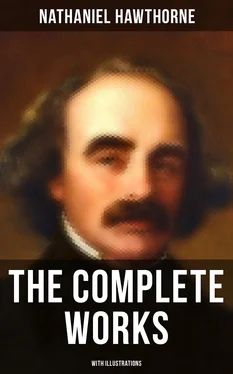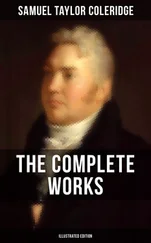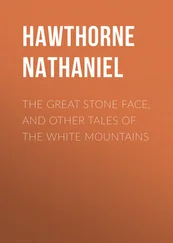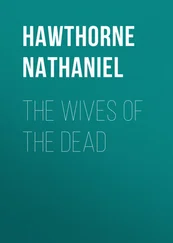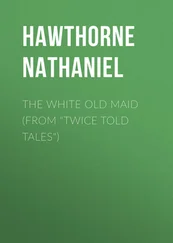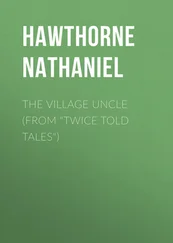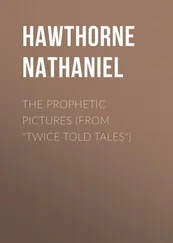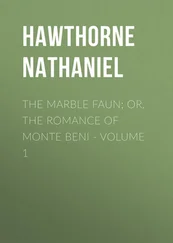CHAPTER V
MIRIAM’S STUDIO
Table of Contents
The courtyard and staircase of a palace built three hundred years ago are a peculiar feature of modern Rome, and interest the stranger more than many things of which he has heard loftier descriptions. You pass through the grand breadth and height of a squalid entrance-way, and perhaps see a range of dusky pillars, forming a sort of cloister round the court, and in the intervals, from pillar to pillar, are strewn fragments of antique statues, headless and legless torsos, and busts that have invariably lost what it might be well if living men could lay aside in that unfragrant atmosphere — the nose. Basreliefs, the spoil of some far older palace, are set in the surrounding walls, every stone of which has been ravished from the Coliseum, or any other imperial ruin which earlier barbarism had not already levelled with the earth. Between two of the pillars, moreover, stands an old sarcophagus without its lid, and with all its more prominently projecting sculptures broken off; perhaps it once held famous dust, and the bony framework of some historic man, although now only a receptacle for the rubbish of the courtyard, and a half-worn broom.
In the centre of the court, under the blue Italian sky, and with the hundred windows of the vast palace gazing down upon it from four sides, appears a fountain. It brims over from one stone basin to another, or gushes from a Naiad’s urn, or spurts its many little jets from the mouths of nameless monsters, which were merely grotesque and artificial when Bernini, or whoever was their unnatural father, first produced them; but now the patches of moss, the tufts of grass, the trailing maidenhair, and all sorts of verdant weeds that thrive in the cracks and crevices of moist marble, tell us that Nature takes the fountain back into her great heart, and cherishes it as kindly as if it were a woodland spring. And hark, the pleasant murmur, the gurgle, the plash! You might hear just those tinkling sounds from any tiny waterfall in the forest, though here they gain a delicious pathos from the stately echoes that reverberate their natural language. So the fountain is not altogether glad, after all its three centuries at play!
In one of the angles of the courtyard, a pillared doorway gives access to the staircase, with its spacious breadth of low marble steps, up which, in former times, have gone the princes and cardinals of the great Roman family who built this palace. Or they have come down, with still grander and loftier mien, on their way to the Vatican or the Quirinal, there to put off their scarlet hats in exchange for the triple crown. But, in fine, all these illustrious personages have gone down their hereditary staircase for the last time, leaving it to be the thoroughfare of ambassadors, English noblemen, American millionnaires, artists, tradesmen, washerwomen, and people of every degree, — all of whom find such gilded and marble-panelled saloons as their pomp and luxury demand, or such homely garrets as their necessity can pay for, within this one multifarious abode. Only, in not a single nook of the palace (built for splendor, and the accommodation of a vast retinue, but with no vision of a happy fireside or any mode of domestic enjoyment) does the humblest or the haughtiest occupant find comfort.
Up such a staircase, on the morning after the scene at the sculpture gallery, sprang the light foot of Donatello. He ascended from story to story, passing lofty doorways, set within rich frames of sculptured marble, and climbing unweariedly upward, until the glories of the first piano and the elegance of the middle height were exchanged for a sort of Alpine region, cold and naked in its aspect. Steps of rough stone, rude wooden balustrades, a brick pavement in the passages, a dingy whitewash on the walls; these were here the palatial features. Finally, he paused before an oaken door, on which was pinned a card, bearing the name of Miriam Schaefer, artist in oils. Here Donatello knocked, and the door immediately fell somewhat ajar; its latch having been pulled up by means of a string on the inside. Passing through a little anteroom, he found himself in Miriam’s presence.
“Come in, wild Faun,” she said, “and tell me the latest news from Arcady!”
The artist was not just then at her easel, but was busied with the feminine task of mending a pair of gloves.
There is something extremely pleasant, and even touching, — at least, of very sweet, soft, and winning effect, — in this peculiarity of needlework, distinguishing women from men. Our own sex is incapable of any such by-play aside from the main business of life; but women — be they of what earthly rank they may, however gifted with intellect or genius, or endowed with awful beauty — have always some little handiwork ready to fill the tiny gap of every vacant moment. A needle is familiar to the fingers of them all. A queen, no doubt, plies it on occasion; the woman poet can use it as adroitly as her pen; the woman’s eye, that has discovered a new star, turns from its glory to send the polished little instrument gleaming along the hem of her kerchief, or to darn a casual fray in her dress. And they have greatly the advantage of us in this respect. The slender thread of silk or cotton keeps them united with the small, familiar, gentle interests of life, the continually operating influences of which do so much for the health of the character, and carry off what would otherwise be a dangerous accumulation of morbid sensibility. A vast deal of human sympathy runs along this electric line, stretching from the throne to the wicker chair of the humblest seamstress, and keeping high and low in a species of communion with their kindred beings. Methinks it is a token of healthy and gentle characteristics, when women of high thoughts and accomplishments love to sew; especially as they are never more at home with their own hearts than while so occupied.
And when the work falls in a woman’s lap, of its own accord, and the needle involuntarily ceases to fly, it is a sign of trouble, quite as trustworthy as the throb of the heart itself. This was what happened to Miriam. Even while Donatello stood gazing at her, she seemed to have forgotten his presence, allowing him to drop out of her thoughts, and the torn glove to fall from her idle fingers. Simple as he was, the young man knew by his sympathies that something was amiss.
“Dear lady, you are sad,” said he, drawing close to her.
“It is nothing, Donatello,” she replied, resuming her work; “yes; a little sad, perhaps; but that is not strange for us people of the ordinary world, especially for women. You are of a cheerfuller race, my friend, and know nothing of this disease of sadness. But why do you come into this shadowy room of mine?”
“Why do you make it so shadowy?” asked he.
“We artists purposely exclude sunshine, and all but a partial light,” said Miriam, “because we think it necessary to put ourselves at odds with Nature before trying to imitate her. That strikes you very strangely, does it not? But we make very pretty pictures sometimes with our artfully arranged lights and shadows. Amuse yourself with some of mine, Donatello, and by and by I shall be in the mood to begin the portrait we were talking about.”
The room had the customary aspect of a painter’s studio; one of those delightful spots that hardly seem to belong to the actual world, but rather to be the outward type of a poet’s haunted imagination, where there are glimpses, sketches, and half-developed hints of beings and objects grander and more beautiful than we can anywhere find in reality. The windows were closed with shutters, or deeply curtained, except one, which was partly open to a sunless portion of the sky, admitting only from high upward that partial light which, with its strongly marked contrast of shadow, is the first requisite towards seeing objects pictorially. Pencil-drawings were pinned against the wall or scattered on the tables. Unframed canvases turned their backs on the spectator, presenting only a blank to the eye, and churlishly concealing whatever riches of scenery or human beauty Miriam’s skill had depicted on the other side.
Читать дальше
